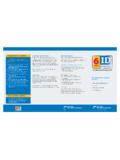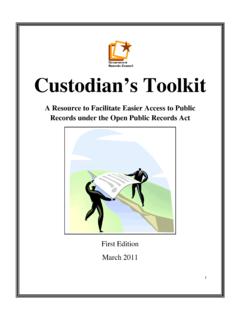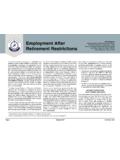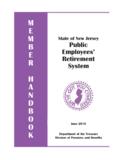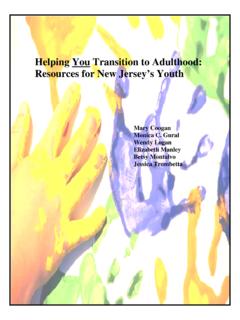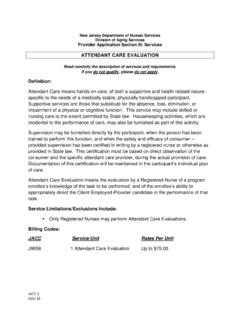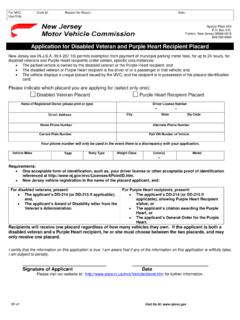Transcription of New Jersey State Department of Education
1 New Jersey State Department of Education Preschool teaching and learning Standards 2014. New Jersey Department of Education 2014 Preschool teaching and learning Standards ACKNOWLEDGMENTS. The New Jersey Department of Education would like to extend its sincere appreciation to State Board of Education member Dr. Dorothy Strickland of Rutgers University; Dr. Herb Ginsberg of Teachers College, and Dr. Marilou Hyson, who reviewed the revised preschool standards in English Language Arts, mathematics , and Approaches to learning . HISTORY. In April 2000, the Department of Education first developed and published Early Childhood Program Expectations: Standards as guidance for adults working with young children. In July 2004, the State Board of Education adopted a revised version of this work, Preschool teaching and learning Expectations: Standards of Quality.
2 Then, in 2007, the Department embarked on the ambitious project of revising the latter work and aligning the preschool standards directly with New Jersey 's K-12 Core Curriculum Content Standards. In 2009, after extensive review by Education experts, stakeholders, and the public, the State Board adopted the Preschool teaching and learning Standards, with additional revisions. In 2013, the standards were modified to directly align with the Common Core Standards, and Approaches to learning was added. ABOUT THIS DOCUMENT. The first four sections of Preschool teaching and learning Standards present information on the theoretical background, development, and use of the preschool standards. This information is essential to effectively using the preschool standards to support the particular needs of all young children in a high-quality preschool program.
3 Next, the preschool standards, along with optimal teaching practices, are provided for the following content areas: social /Emotional Development, Visual and Performing Arts, Health, Safety, and Physical Education , English Language Arts, Approaches to learning , mathematics , Science, social Studies, Family, and Life Skills, World Languages, Technology The document concludes with a bibliography of books, articles, and periodicals that are valuable resources for any professional library. -1- New Jersey Department of Education 2014 Preschool teaching and learning Standards The Numbering of the Preschool Standards Each of the preschool standards and indicators is assigned two numbers. First, each is numbered as part of this document, Preschool teaching and learning Standards. Second, all preschool indicators are included in the P-12 database, where they are numbered using a five-digit code, as follows: X.
4 X. X.. content area/standard grade strand indicator Preschool teaching and learning Standards presents both numbers for every preschool indicator: (1) the preschool indicator number is in a column to the left of each indicator, and (2). the P-12 database indicator number is in a column to the right of each indicator. -2- New Jersey Department of Education 2014 Preschool teaching and learning Standards State BOARD OF Education . ARCELIO APONTE . Middlesex President JOSEPH FISICARO .. Burlington Vice President MARK W. BIEDRON .. Hunterdon RONALD K. BUTCHER .. Gloucester CLAIRE CHAMBERLAIN .. Somerset JACK FORNARO .. Warren EDITHE FULTON . Ocean ROBERT P. HANEY Monmouth ERNEST P. LEPORE .. Hudson ANDREW J. MULVIHILL Sussex J. PETER SIMON . Morris DOROTHY S. STRICKLAND .. Essex David Hespe, Acting Commissioner Secretary, State Board of Education -3- New Jersey Department of Education 2014 Preschool teaching and learning Standards TABLE OF CONTENTS.
5 PREFACE. ACKNOWLEDGMENTS ..1. HISTORY ..1. ABOUT THIS DOCUMENT ..1. The Numbering of the Preschool Standards ..1. State BOARD OF Education ..3. BACKGROUND ..5. HOME, SCHOOL, AND COMMUNITY PARTNERSHIPS ..9. learning ENVIRONMENT ..12. THE DOCUMENTATION/ASSESSMENT social /EMOTIONAL DEVELOPMENT ..20. VISUAL & PERFORMING ARTS ..26. HEALTH, SAFETY, AND PHYSICAL Education ..33. ENGLISH LANGUAGE ARTS ..37. APPROACHES TO learning ..60. mathematics ..69. SCIENCE ..78. social STUDIES, FAMILY, AND LIFE SKILLS ..85. WORLD LANGUAGES ..89. TECHNOLOGY ..91. BIBLIOGRAPHY ..95. -4- New Jersey Department of Education 2014 Preschool teaching and learning Standards BACKGROUND. The 2013 preschool teaching and learning standards are grounded in a strong theoretical framework for delivering high quality educational experiences to young children.
6 The Preschool teaching and learning Standards document: Defines supportive learning environments for preschool children. Provides guidance on the assessment of young children. Articulates optimal relationships between and among families, the community, and preschools. Identifies expected learning outcomes for preschool children by domain, as well as developmentally appropriate teaching practices that are known to support those outcomes. The preschool standards represent what preschool children know and can do in the context of a high quality preschool classroom. Childhood experiences can have long-lasting implications for the future. The earliest years of schooling can promote positive developmental experiences and independence while also optimizing learning and development. The Standards and the Classroom Curriculum As with the K-12 content standards, the preschool standards were written for all school districts in the State .
7 They are intended to be used as: A resource for ensuring appropriate implementation of the curriculum A guide for instructional planning A framework for ongoing professional development A framework for the development of a comprehensive early childhood Education assessment system The curriculum is defined as an educational philosophy for achieving desired educational outcomes through the presentation of an organized scope and sequence of activities with a description and/or inclusion of appropriate instructional materials. The preschool standards are not a curriculum, but are the learning targets for a curriculum. All preschool programs must implement a comprehensive, evidence-based preschool curriculum in order to meet the preschool standards. Developmentally appropriate teaching practices scaffold successful achievement of the preschool standards.
8 Such practice is based on knowledge about how children learn and develop, how children vary in their development, and how best to support children's learning and development. It is important to note, therefore, that although the preschool domains are presented as discrete areas in this document, the program must be delivered in an integrated manner through the curriculum's daily routines, activities, and interactions. Preschool educational experiences are intended to stimulate, assist, support, and sustain emergent skills. Preschools aim to offer experiences that maximize young children's learning and development, providing each child with a foundation for current and future school success. -5- New Jersey Department of Education 2014 Preschool teaching and learning Standards Issues of Implementation This document was developed for implementation in any program serving preschool children.
9 To ensure that all students achieve the standards, the preschool environment, instructional materials, and teaching strategies should be adapted as appropriate to meet the needs of individual children. The needs of preschool learners are diverse. Many learners need specialized and focused interventions to support and sustain their educational progress. In addition, they come from many different cultural and ethnic backgrounds, and in some cases, the dominant language spoken in these homes and communities is not English. Special Education Needs Careful planning is needed to ensure the successful inclusion of preschoolers with disabilities in general Education programs. The focus should be on identifying individual student needs, linking instruction to the preschool curriculum, providing appropriate supports and program modifications, and regularly evaluating student progress.
10 The preschool standards provide the focus for the development of Individualized Education Plans (IEPs) for preschool children ages three and four with disabilities. Providing appropriate intervention services to such students is in accordance with the Individuals with Disabilities Act Amendments of 2004, which guarantee students with disabilities the right to general Education program adaptations, as specified in their IEPs and with parental consent. These federal requirements necessitate the development of adaptations that provide preschool children with disabilities full access to the preschool Education program and curriculum. Such adaptations are not intended to compromise the learning outcomes; rather, adaptations provide children with disabilities the opportunity to develop their strengths and compensate for their learning differences as they work toward the learning outcomes set for all children.
